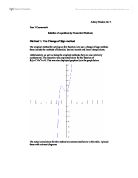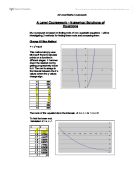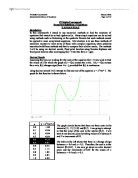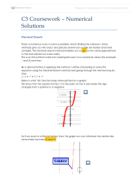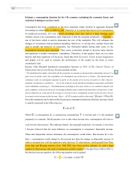Statistics Coursework
STATISTICS COURSEWORK Tesheen Moosa Statistics Coursework Introduction I have been asked to examine the student's attendance figures from all year groups (7, 8, 9, 10 and 11) at Hamilton Community College. I will be investigating whether the age of the students affects their attendance figures at school and does it affect their learning and exam results as well? To start my research, I was given the attendance figures by the school for all of the year groups for the 2003 - 2004 academic years. I will then start to process data (attendance figures) firstly by reducing the amount of data that I will have to process using the method of stratified sampling. By using stratified sampling I will then only use a fair amount of data according to the percentage that I'm comfortable with. I will only be using 20% of the attendance figures from each year. A scientific calculator is used, to randomly select attendance figures that I am going to use, so that the new set of statistics isn't bias and isn't affected by my conscious decision. Using the new set of data, I will collate the data in frequency tables (to display all of the frequency distributions), in order to enable easy interpretation and analysis. Secondly, after collating the data, I will then display the new set of data in forms of graphs/diagrams and charts so that it will be easier for me to compare and study the
Reaction Times
Reaction Times Plan Hypotheses: 1) Boys are faster than girls are 2) Right-handed students are faster than left-handed students are 3) Right-handed boys are faster than right-handed girls are Possible methods of testing . Hit the mole (arcade game)- I would time how many moles they could hit in one minute, repeat this 3 times to get a fair result and then find an average. This would be read as the higher the number of moles that are hit, the faster the reaction. However you would have to travel to an arcade to carry this test out and it would be extremely expensive. 2. Stopwatch- I would tell the student to stop it at a certain time e.g. 2 minutes, and however many seconds before or after they stopped the stopwatch, would be their reaction time, the closer the number of seconds it is to 2 minutes, the faster the reaction. This would of course be repeated 3 times to get a fair result and then the average found. However the stopwatch buttons may get stuck, therefore altering results. 3. Dropping a ruler- I would take a 30cm ruler and make sure that the zero is inline with the index finger. I would then drop the ruler, which would be caught by the student (who is standing), then the number of cm's nearest to the index finger where the zero was lined up with, would be taken down as the reading for their reaction times. The results would be read as, the lower the number
Solution of equations by numerical methods.
Solution of equations by numerical methods This investigation is to find equation solutions using three methods: . Change of sign using bisection, decimal search or linear interpolation. 2. Newton - Raphson. 3. Rearrangement of the equation f(x) = 0 into the form x = g(x). The change of sign methods are systematic searches, which use the positive and negative signs of the f(x) solutions to find the location of the root within the intervals found using the graph of the function curve. The change of sign method I have chosen to use within my investigation is the decimal search method. Fixed point iteration requires finding a single value or point as an estimation for the value of x, rather than establishing an interval as in the change of sign methods. The Newton - Raphson method and the rearrangement of equation f(x) = 0 into the form x = g(x) will be used to investigate this form of numerical equation solution. Once each of these methods have been investigated I will compare each of them, in order to find the easiest method for equation solution. This comparison will also include the negative and positive points of each method, such as problems that result in an inability to find the correct root and the speed of convergence to the correct root. Fixed Point Iteration - Newton - Raphson Method. To start off using the Newton - Raphson method, we must first take an
Solution of equations by Numerical Methods.
Ashley Hilsdon Div 3 Pure 2 Coursework Solution of equations by Numerical Methods Method 1: The Change of Sign method The simplest method for solving an f(x) function is to use a change of sign method; these include the methods of bisection, decimal search and linear interpolations. Unfortunately, as well as being the simplest methods, they are also relatively cumbersome. The bisection was employed below for the function of f(x)=x5+3x2+x+2. This was also displayed graphically in the graph below. The actual calculations for this method are summarised below in this table. I placed these with relevant diagrams The error bounds for this result are conveniently provided by the use of this method, and are -1.485<x<-1.475. The maximum error is therefore ± 0.005. However, this method is clearly not particularly easy to work with. In addition, as with many methods there are some functions for x, which do not work. An example is the function f(x)=x3-2x2-x. This is shown below. The problem in this situation is the fact that there is in fact two roots in a very short space. (Labelled (a.) and (b.) on the graph). Using the bisection method within the interval of [-1, 0], this is bisected into 0.5. The root of 0 is the one to which the calculations tend. However, the other root, of -0.4142 (to 5 s.f.) is missed. This is illustrated in more detail in the diagram below. Method
Solving Equations using Numerical Methods.
A2 Pure Maths Coursework Solving Equations using Numerical Methods There are three methods with which you can solve an equation. . Change of Sign Method 2. Newton-Raphson Method 3. Rearranging the equation f(x)=0 in the form x= g(x) Hardware and Software Used For the coursework I have used a computer for attaining more accurate results and to avoid errors. The software I have used are * Microsoft Word * GraphCalc (A software used for drawing graphs) Change of Sign Method x4- 4x +2 We see that the roots lie in between [0, 1] and [1, 2] We confirm this by looking for a change of sign x 0 2 f(x) 2 -1 0 f(x) is found by substituting the values of x in the equation. We look for roots in [0, 1] x 0 0.1 0.2 0.3 0.4 0.5 0.6 f(x) 2 .6001 .2016 0.8081 0.4256 0.0625 -0.2704 We look for roots in [0.5, 0.6] x 0.5 0.51 0.52 f(x) 0.0625 0.02765 -0.00688 We look for roots in [0.51, 0.52] x 0.51 0.511 0.512 0.513 0.514 0.515 0.516 0.517 0.518 f(x) 0.02765 0.02418 0.02071 0.01725 0.01380 0.01034 0.00689 0.00344 -0.000002 We look for roots in [0.517, 0.518] x 0.517 0.5171 0.5172 0.5173 0.5174 f(x) 0.00344 0.00309 0.00275 0.0024 0.00206 x 0.5175 0.5176 0.5177 0.5178 0.5179 0.518 f(x) 0.00172 0.00137 0.00103 0.00068 0.00034 -0.000002 Root is in between [0.5179, 0.5180] Failure Case There are some
Numerical Solutions of Equations
A Level Coursework - Numerical Solutions of Equations My coursework is based on finding roots of non-quadratic equations. I will be investigating 3 methods for finding these roots and comparing them. Change Of Sign Method Y = x4+4x-6 This method simply uses Microsoft Excel to tabulate points on a function in different stages. It 'narrows down' the desired root by getting progressively closer to it. The root is always in the interval between the 2 x values where the y values change sign. -5 599 -4 234 -3 63 -2 2 -1 -9 0 -6 -1 2 8 3 87 4 266 5 639 The roots of this equation lie in the intervals -2 < x < -1 & 1 < x < 2. To find the lower root, I tabulated -2 < x < -1. x y -2 2 -1.9 -0.5679 -1.8 -2.7024 -1.7 -4.4479 -1.6 -5.8464 -1.5 -6.9375 -1.4 -7.7584 -1.3 -8.3439 -1.2 -8.7264 -1.1 -8.9359 -1 -9 There is a change of sign between -2 & -1.9, therefore the boundaries of the root lie in this interval. I tabulated in steps of 0.01, and again in steps of 0.001 & 0.0001 x y -2 2 -1.99 .722392 -1.98 .449536 -1.97 .181385 -1.96 0.917891 -1.95 0.659006 -1.94 0.404685 -1.93 0.15488 -1.92 -0.09046 -1.91 -0.33137 -1.9 -0.5679 From this we have established the root lies between -1.9237 & -1.9238. I tabulated this one more time. x y -1.9238 0.002248669 -1.92379 0.002003871 -1.92378 0.001759078 -1.92377
Numerical Solutions of Equations.
P2 Maths Coursework Numerical Solutions of Equations HANNAN SHAH Introduction In this coursework I intend to use numerical methods to find the solutions of equations that cannot be solved algebraically. Many simple equations can be solved using methods such as factorising or the quadratic formula but such methods cannot be applied to more complicated equations. My intention is to use three methods of numerical analysis to solve some of these more complex equations, show problems associated with these methods and then to compare their relative merits. The methods I will be using are decimal search, fixed point iteration using Newton-Raphson and fixed point iteration after rearranging f(x) = 0 into the form x = g(x). Decimal Search Assuming that you are looking for the roots of the equation f(x) = 0 you want to find the values of x for which the graph of y = f(x) crosses the x-axis. As y = f(x) crosses the x-axis, f(x) changes sign (from + to -), provided that f(x) is continuous. Using decimal search I will attempt to find one root of the equation y = x5+4x²-1. The graph for this function is shown below. The graph clearly shows that there are three roots in the intervals [-2, -1]. [-1,0] and [0,1]. I am going to attempt to find the value of the root in the interval [0,1]. I will start at one decimal place by taking values of x between 0 and 1 in increments of





